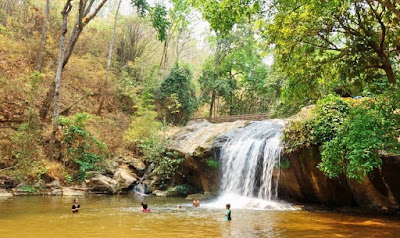The Lao government laid out its plan to nurture Vang Vieng district into the country’s “official tourism town” by 2020, and signs are emerging that this goal is one step closer to completion.
The Asian Development Bank (ADB) has announced that it is providing USD 47 million for infrastructure development in the district and around the Nam Ngum reservoir to accommodate the growth of tourism.
The planned developments, which are expected to begin next year, include a wharf, parking facilities, community market, and a fishing village, as well as a garbage collection site, Vientiane Times reported on August 23.
In addition, a 6-kilometer road will be built to connect with Road No. 10, which should help to address congestion around the reservoir.
Separately, China’s Xinhua News Agency has published a six images providing a quick peek at the construction site of the Vientiane-Vang Vieng expressway, well underway.
The Vientiane-Vang Vieng expressway is a part of the China-Laos expressway, which is co-developed by China Yunnan Construction and Investment Holding Group and the Lao Ministry of Planning and Investment.
The planned developments, which are expected to begin next year, include a wharf, parking facilities, community market, and a fishing village, as well as a garbage collection site, Vientiane Times reported on August 23.
In addition, a 6-kilometer road will be built to connect with Road No. 10, which should help to address congestion around the reservoir.
Separately, China’s Xinhua News Agency has published a six images providing a quick peek at the construction site of the Vientiane-Vang Vieng expressway, well underway.
The Vientiane-Vang Vieng expressway is a part of the China-Laos expressway, which is co-developed by China Yunnan Construction and Investment Holding Group and the Lao Ministry of Planning and Investment.
.
.
The Vientiane to Vangvieng section stretches 109.1 kilometers and is expected to shorten the travel time from the current four hours to just 1.5 hours, according to Xinhua.
Laos and China agreed in November last year to begin construction on the USD 1.2 billion road to link Sikeuth village in Naxaithong District, Vientiane, to the Vang Vieng District.
At that time, it was estimated that it would take about three years to complete the construction.
Vang Vieng is already one of the top tourist destinations in Laos, many areas desperately need improvements, such as road access to visitor attractions, cleanliness, services, and tourism-related facilities.
Prime Minister Thongloun recently made a working trip to Vang Vieng to assess the district and offer advice on how to better develop the tourist town.
Laos and China agreed in November last year to begin construction on the USD 1.2 billion road to link Sikeuth village in Naxaithong District, Vientiane, to the Vang Vieng District.
At that time, it was estimated that it would take about three years to complete the construction.
Vang Vieng is already one of the top tourist destinations in Laos, many areas desperately need improvements, such as road access to visitor attractions, cleanliness, services, and tourism-related facilities.
Prime Minister Thongloun recently made a working trip to Vang Vieng to assess the district and offer advice on how to better develop the tourist town.
.
.
In May last year, the Lao government set a total of 108 requirements to meet before Vang Vieng can be designated a tourism town and has been working toward this goal since then.
In addition, district authorities have been collecting information on the tourism industry to take it to the central government for detailed discussion.
Vang Vieng sees more than 10,000 tourists every month, with South Koreans accounting for 70 percent, along with Chinese, Lao and others, according to the district’s estimation.
In addition, district authorities have been collecting information on the tourism industry to take it to the central government for detailed discussion.
Vang Vieng sees more than 10,000 tourists every month, with South Koreans accounting for 70 percent, along with Chinese, Lao and others, according to the district’s estimation.
Source - The Laotian Times
.











































